This post may contain affiliate links. Please read my disclosure policy.
Today we are talking all about tap water, what’s in it, what you should know, tap water quality and testing, and how to make sure the water we’re using daily is good for us!
If there’s something that all of us definitely have in common, it’s one of our most basic needs: water.
Staying hydrated by drinking water is of course necessary, but our reliance on water goes way deeper than that. How many times every day do you use water in your home? We use water for cooking, bathing, cleaning… the list goes on. If you need some coffee to get your day started, you probably haven’t even wiped the sleep from your eyes before you’ve turned on the tap to get your first cup of joe going! If you were to actually tally it up, I bet you’d be pretty surprised at just how much!
We’ve been told that here in the U.S., most of us are lucky enough to have easy access to clean water. But while our water supply is cleaner and safer than what people in other locations might have, it can’t necessarily be trusted all the time. It never hurts to be informed about what’s really flowing in the water that you and your loved ones use on a near-constant basis — and to understand that there are ways to make sure it’s as safe as possible.
I learned this lesson all too well in my own home recently — and I’ll share more of my personal story later in this post.
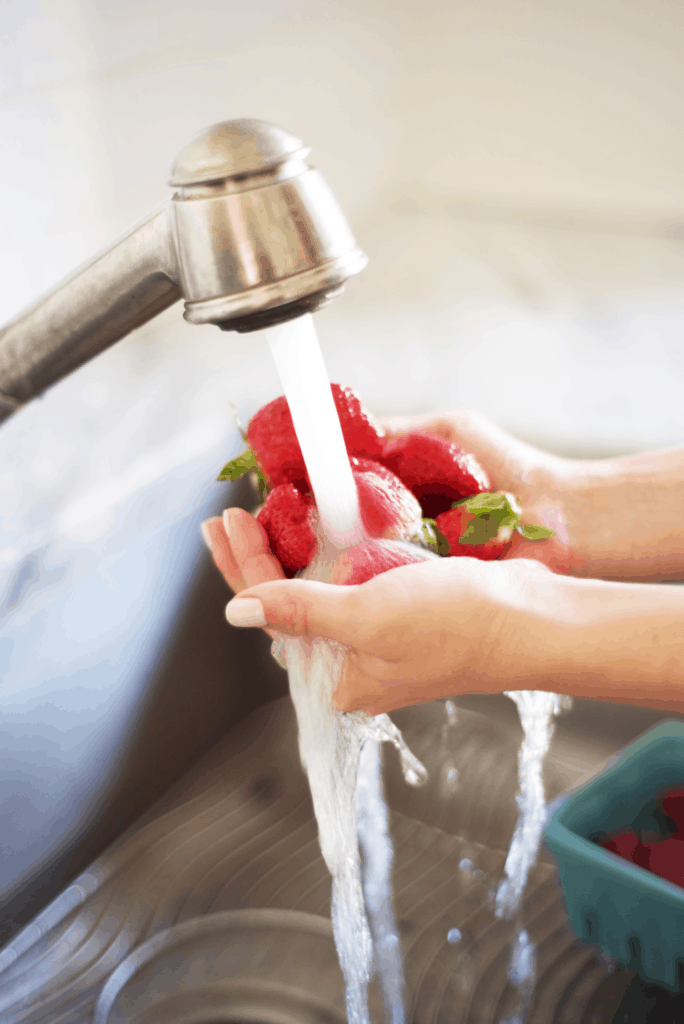
Tap Water 101
Tap water quality
First, I’m going to give you some context. The Environmental Protection Agency originally established the Safe Drinking Water Act in 1974 with the intent of protecting the quality of drinking water for all Americans. The EPA made several amendments to the Safe Drinking Water Act to add additional protection.
But here’s a fun — no, a disturbing — fact: the EPA has not added any new contaminants to the toxic chemicals covered by the Safe Drinking Water Act since 2000. Yep. You read that right. It’s been more than twenty years since this regulatory agency adjusted the standards for the water we use every day. And it’s not as if these toxic chemicals are just going away!
The Environmental Working Group maintains a Tap Water Database that collects data from nearly 50,000 local utilities in all 50 states. According to the data used in the database, many Americans are drinking a dose of dangerous chemicals with every glass of tap water. These contaminants are proven carcinogens, have been known to harm the brain and nervous system, can impact the development of a fetus during pregnancy, can reduce fertility, and disrupt hormones. And because the EPA has not made the moves necessary to update the list of toxic chemicals that can make tap water illegal, we definitely can’t be confident that the water flowing into our homes is safe.
Yikes.
What’s In Our Tap Water?
To help you understand the full picture of what we’re dealing with, here are some of the most concerning contaminants found — and allowed by the EPA! — in tap water today, according to Aquasana.
- Lead — This toxic metal is often introduced to tap water when household plumbing systems become corroded. Lead can be dangerous even in small doses.
- Chlorine — You’re not supposed to drink pool water, and it’s because of chlorine! Many municipal water systems add chlorine to control the growth of microbes, which results in dry skin, dry hair, and an irritated ENT system.
- Chloramines — When ammonia is added to water that contains free chlorine, the result is the formation of chloramines, which are a disinfectant. When chloramines mix with the materials that naturally occur in water, you get disinfectant byproducts, which are carcinogenic.
- Mercury — This liquid metal is found in natural deposits and finds its way into tap water from erosion, refineries, factories, landfill runoff, and crop runoff. (It sounds pretty gross because, well, it is.) Over time, exposure to high levels of mercury can damage your kidneys.
- Volatile Organic Compounds (VOCs) — This category includes a variety of chemicals that are emitted from gases. VOCs are, unfortunately, found in many household products, which is why they often end up in our water.
- Pharmaceuticals — When manufacturing facilities are not properly controlled and medications are not disposed of in the right way, traces of prescription drugs for both humans and animals can show up in tap water.
- Herbicides — These chemicals are put to use for controlling undesirable plant life, and they can seep into public water supply via rainfall and irrigation. Common herbicides have been known to cause issues with hormones and reproduction.
- Pesticides — Pesticides run out of our drains into water treatment plants, where they aren’t actually treated and removed from the water we then drink and bathe in. There are literally hundreds of compounds in these pesticides, and research hasn’t even been able to document the many ways in which they can harm us.
- Cysts — These microbial parasites come from lakes and rivers and come through sewage, leaky septic tanks, and runoff into tap water. Even if they do make it into water treatment facilities, cysts are actually resistant to water disinfection processes, so there’s not much that can be done about them.
- Methyl Tertiary Butyl Ether (MTBE) — This flammable liquid is used in gasoline to reduce carbon monoxide and ozone levels from auto emissions. And… yeah. It can end up in your water. Gross!
Branch Basics notes a few other contaminants that are common in tap water.
- Fungicides
- Flame retardant
- Parasites and bacteria from fecal matter
- Radiation
It’s also worth noting that even the toxic chemicals that are technically covered by the Safe Drinking Water Act are not regulated as much as they should be. Per the Environmental Working Group, the legal limit on these contaminants is often hundreds of times higher than the health standards recommended by experts. Regulators determine these limits based on what’s achievable at a relatively low cost. And it’s happening at the expense of our health!
After years and years of taking in these dangerous substances through water, your body experiences “bioaccumulation,” which increases the risk of certain diseases and health problems.
I know this sounds really scary… and it is!
It’s hard to believe that our regulatory system is so broken that we can’t ensure that toxins like this are kept out of the water we drink. We’re told that we’re lucky to have access to clean water — but that’s only because we’re not getting all the information.
How Can We Check Our Tap Water Quality?
If you’re looking for that information, I would recommend staying keyed into EWG’s Tap Water Database on an ongoing basis. You can sign up for regular updates from them so you can be as informed as possible about the contaminants that might be showing up in your water.
Tap water testing:
I would also recommend doing a home water test. Conducting a test like this independent from local governments or regulatory agencies means that you’ll get the whole truth about what’s lurking in your H2O. Tap Score is a great option! In addition to offering you a report that breaks these contaminants down, Tap Score gives a health analysis based on each report. This way, you’ll really know what you’re up against!
As you know, I don’t like to hit you with this kind of bad news without offering some solutions. Information is power, and that includes information about how we can make unhealthy situations better for ourselves and our families.
How we can make our water healthier?
We’ve talked about the broader issues with the water supply in the U.S. You have some tools to support you in your search for answers about what’s going on with the water in your particular home.
Tap Water Filters
What’s the best way to go about improving the situation? The short answer: tap water filters.
Water filters are an expense, but given all of the information I’ve just shared, I think it’s clear that they’re a worthwhile investment. Personally, I’d rather cut back somewhere else and invest in this (more on what we did below). Purchasing a water filter will give you peace of mind, since you’ll know the water you and your loved ones are consuming is free of the toxins that can make you sick.
Plus, a water filter will eliminate the need for purchasing bottled water, which is also an expense. If you buy a lot of bottled water, purchasing a water filter might actually save you money in the long run!
Here’s what I learned: Water filters are not one size fits all. For example, my home uses a septic system, so a full-house reverse osmosis system actually isn’t an option. (It’s also pretty wasteful.)
This is where it takes some research! Here are a few tips via Branch Basics to help you start the process of researching and purchasing a water filter of your own…
- Consider what makes sense for your home. For example, if you’re renting, it’s not practical to invest in a custom-designed unit for your whole home, so something like a Berkey filter is a great option. If you’re more settled in a house or apartment, you might feel more comfortable going big. (Read on for more details about the different kinds of systems that are out there.)
- Find a system that goes beyond the basics. Every little bit of filtration helps, of course, but I recommend looking for a multi-stage filter that does more than filter out chlorine and lead. As you read above, the problems with our tap water are bigger than just those two contaminants!
- Read testing reports. Most of the manufacturers that produce water filters will circulate water testing reports so you can access all the details about how effective they are. If you can’t find these reports on a company’s website, their products may not be especially reputable.
- Avoid standard fluoride water filters. These have been around for a while, but don’t be fooled!
- Find filters with a 1 micron absolute-rated ceramic filter. This kind of filter will remove parasites and bacteria from your tap water.
Here are the various types of water filters on the market:
- Countertop filters, which are great for apartments and rentals. Look for multi-filter systems that will filter out fluoride and heavy metals. I like Berkey filters, as they use charcoal filters! We have two of these.
- Under-the-sink filters, which take up minimal space and are a solid low-budget option. You can customize these filters based on the toxins you’re most concerned with.
- Reverse osmosis filters, which are more expensive than under-the-sink products and require more water than the alternatives, but filter PFAs and a whole lot more. P.S. You can also get an RO system just for the sink (you’ll see we did this and why below)!
- Granular activated carbon (GAC) filters, which are also known as charcoal filters. Like reverse osmosis filters, these are effective at removing many of the compounds that labs typically analyze when investigating contaminated water.
- Gravity-fed countertop filters, which are both portable and affordable. If you’re going this route, choose a stainless steel product with an effective fluoride filter and clean it regularly.
Whole house filters, which — as you can probably guess based on the name — are the biggest investment of the bunch. A filter like this will protect the water you use for drinking, cooking, and bathing all at once. (Speaking of which, if you don’t want to spend the money on a whole house filter but are concerned about the H2O in your bath or shower, you can purchase filters for each of your separate bath and shower fixtures.)
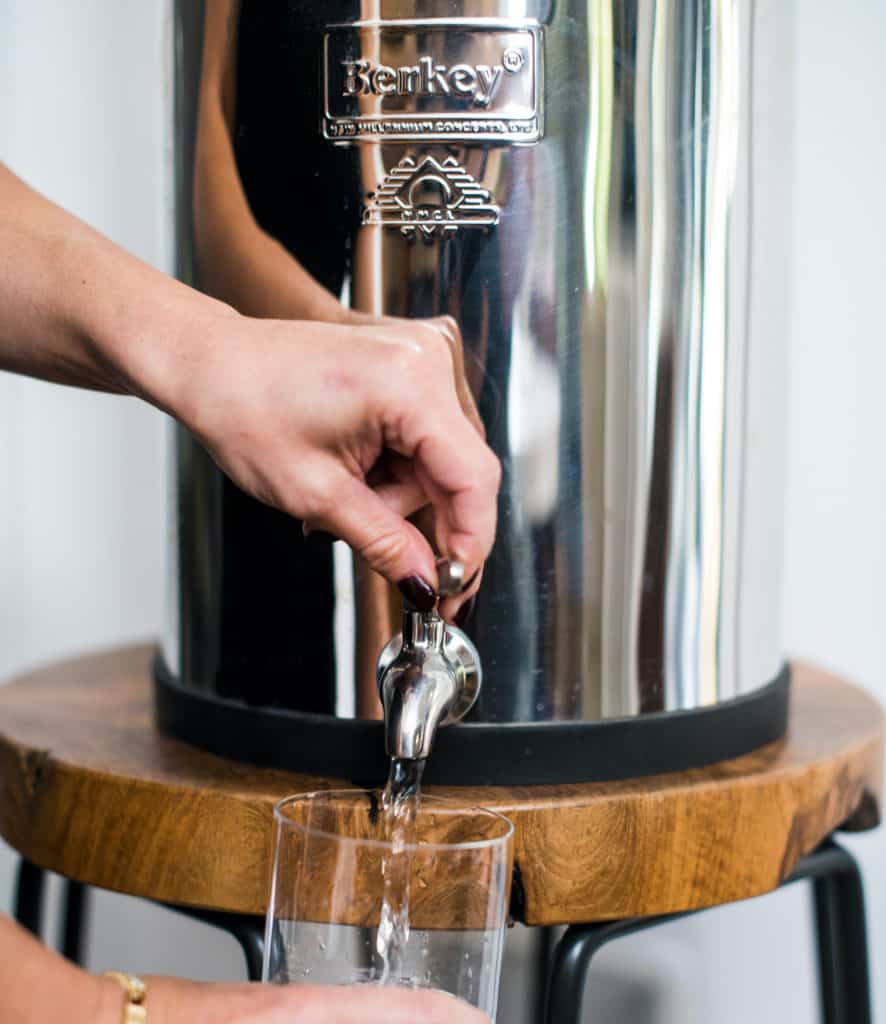
Our Tap Water/Water Filter Story:
A few months ago, we received a letter that the water in our town tested high for PFAs (you may know these as a component of teflon pans). We were encouraged — especially if we had infants or were nursing, which we did and were — to stop drinking the water immediately.
Note: PFAs cannot be boiled out of water, and once they’re in your body, it’s extremely difficult to detox. These are serious chemicals — and they’re found in tap water across the U.S. I avoid them as much as possible in our daily lives, in general. (More on that here via EWG.)
P.S. You can check out your town’s water here or here.
We made the decision to really filter the water in our home.
As you can imagine, I was super concerned and upset about this news. I was already using Berkey filters in our home due to the high chlorine and other various things we identified in a water test (through a local company), but we decided it was time to figure out a larger, more permanent solution. Since we were using our water for more than drinking, we needed to kick it up a notch from the Berkey filters, which I still love.
Since we had a young baby and we needed clean water urgently, we went with an under-the-sink RO system to start. (A whole house RO is not an option for us because our house uses septic, which makes a whole house filter very wasteful.)
After that, we worked with a local company we trusted and figured out a whole house plan that didn’t require us to open up walls in our basement. We knew water softeners were necessary before we could do much more filtering because our water here is SO hard and we’d be burning through any type of filter without it (see here how every situation will be so different).
Here’s Where We Landed With Our Tap Water:
Essentially, we ended up with a water softening system and carbon block filters. Our water is basically spring water now. It’s amazing!
Our current system filters out chlorine, chloramine, lead, and FOA/PFAS. It also removes and reduces numerous other contaminants. It is third party certified with NSF Standard 53 and P-473 for PFAS-PFOA, Lead, Chlorine, Chloramine and waterborne cysts. After everything I learned about tap water, I wasn’t willing to budge on this and I’m so glad we made the investment.
Of course, this may not be what your home needs. In fact, it likely isn’t! Do your research and look into that tap water of yours so you can make some decisions that will work for your family.
As is true with most things, the safety of our water supply is pretty scary… but there are ways around it. I hope this information has helped you feel more empowered to make the water in your home as clean as possible so you can drink up without worry!
If You Found This Helpful, Check Out These Other Articles:
- Why I Switched Our Cleaning Supplies
- Non-Toxic Baby Toys
- We Need to Talk About Fragrance
- Everything You Need to Know About Coffee
- Matcha 101: What is Matcha and Everything Else You Should Know
Pin This Article For Later:
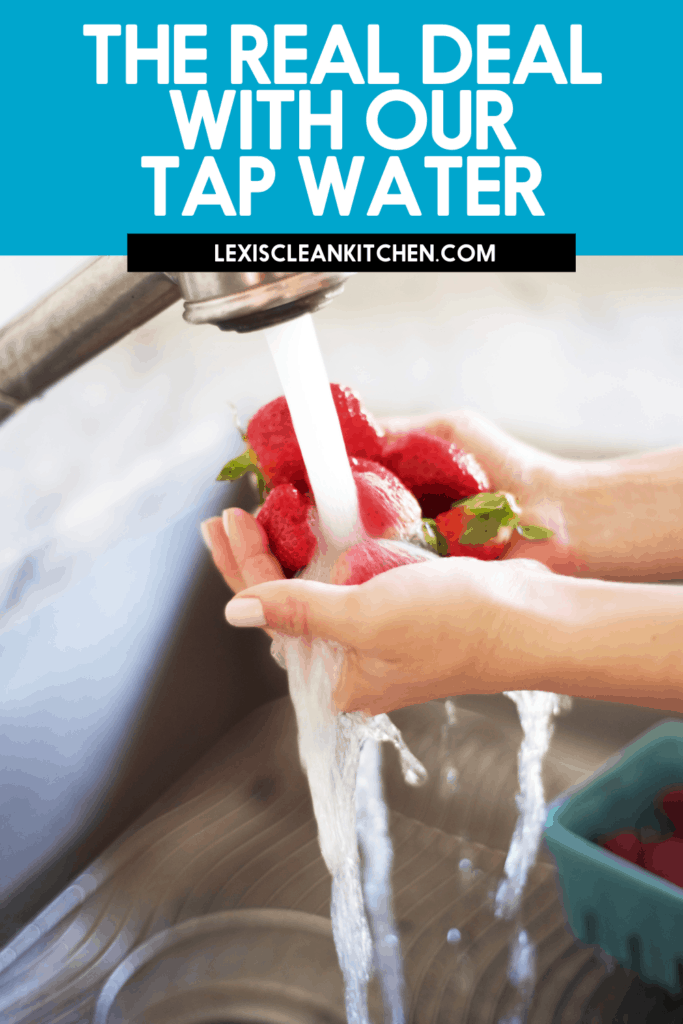
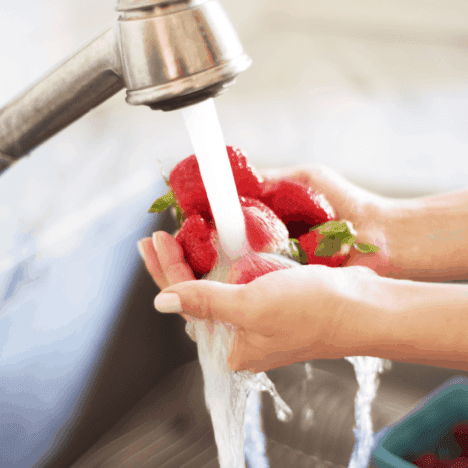


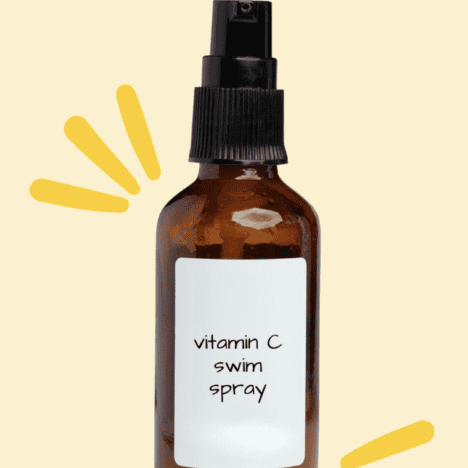


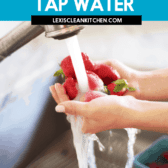
Love how Lexi takes the time to inform us about important lifestyle concerns! THANK YOU!!!
Can you please share the exact water softener/filter you got? I have been in the market for one but was overwhelmed by the different options.
Sure, but as noted, every house will be very different in needs/what you need to do or spend:
1. AtlasFiltri Duo housing filter with 1 micron melt blown sediment & 5 micron high flow carbon block cartridges.
2. 2.0 Cube AquaBubble backwashable softener with a 1.25” control for a 10 gallon per minute service flow rate (fully softened water) and a 15 GPM peak flow rate (not fully softened).
3. Two (2) US Made Enpress “Pioneer” single 0.5 micron carbon block filter cartridge floor tanks.
Thank you for this post! I’ve been stressing over our water for a while and have felt overwhelmed by all of the options out there. This article helps to break everything down. I live in Central MA so I’m curious if you would be willing to share the company you worked with? Thanks!!
Email me I’ll send you info: lexiscleankitchen@gmail.com